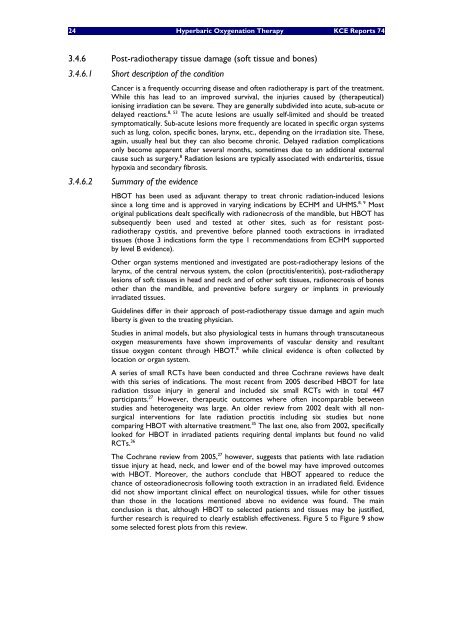Hyperbare Zuurstoftherapie: Rapid Assessment - KCE
Hyperbare Zuurstoftherapie: Rapid Assessment - KCE
Hyperbare Zuurstoftherapie: Rapid Assessment - KCE
Create successful ePaper yourself
Turn your PDF publications into a flip-book with our unique Google optimized e-Paper software.
24 Hyperbaric Oxygenation Therapy <strong>KCE</strong> Reports 74<br />
3.4.6 Post-radiotherapy tissue damage (soft tissue and bones)<br />
3.4.6.1 Short description of the condition<br />
Cancer is a frequently occurring disease and often radiotherapy is part of the treatment.<br />
While this has lead to an improved survival, the injuries caused by (therapeutical)<br />
ionising irradiation can be severe. They are generally subdivided into acute, sub-acute or<br />
delayed reactions. 8, 53 The acute lesions are usually self-limited and should be treated<br />
symptomatically. Sub-acute lesions more frequently are located in specific organ systems<br />
such as lung, colon, specific bones, larynx, etc., depending on the irradiation site. These,<br />
again, usually heal but they can also become chronic. Delayed radiation complications<br />
only become apparent after several months, sometimes due to an additional external<br />
cause such as surgery. 8 Radiation lesions are typically associated with endarteritis, tissue<br />
hypoxia and secondary fibrosis.<br />
3.4.6.2 Summary of the evidence<br />
HBOT has been used as adjuvant therapy to treat chronic radiation-induced lesions<br />
since a long time and is approved in varying indications by ECHM and UHMS. 8, 9 Most<br />
original publications dealt specifically with radionecrosis of the mandible, but HBOT has<br />
subsequently been used and tested at other sites, such as for resistant postradiotherapy<br />
cystitis, and preventive before planned tooth extractions in irradiated<br />
tissues (those 3 indications form the type 1 recommendations from ECHM supported<br />
by level B evidence).<br />
Other organ systems mentioned and investigated are post-radiotherapy lesions of the<br />
larynx, of the central nervous system, the colon (proctitis/enteritis), post-radiotherapy<br />
lesions of soft tissues in head and neck and of other soft tissues, radionecrosis of bones<br />
other than the mandible, and preventive before surgery or implants in previously<br />
irradiated tissues.<br />
Guidelines differ in their approach of post-radiotherapy tissue damage and again much<br />
liberty is given to the treating physician.<br />
Studies in animal models, but also physiological tests in humans through transcutaneous<br />
oxygen measurements have shown improvements of vascular density and resultant<br />
tissue oxygen content through HBOT. 8 while clinical evidence is often collected by<br />
location or organ system.<br />
A series of small RCTs have been conducted and three Cochrane reviews have dealt<br />
with this series of indications. The most recent from 2005 described HBOT for late<br />
radiation tissue injury in general and included six small RCTs with in total 447<br />
participants. 27 However, therapeutic outcomes where often incomparable between<br />
studies and heterogeneity was large. An older review from 2002 dealt with all nonsurgical<br />
interventions for late radiation proctitis including six studies but none<br />
comparing HBOT with alternative treatment. 35 The last one, also from 2002, specifically<br />
looked for HBOT in irradiated patients requiring dental implants but found no valid<br />
RCTs. 36<br />
The Cochrane review from 2005, 27 however, suggests that patients with late radiation<br />
tissue injury at head, neck, and lower end of the bowel may have improved outcomes<br />
with HBOT. Moreover, the authors conclude that HBOT appeared to reduce the<br />
chance of osteoradionecrosis following tooth extraction in an irradiated field. Evidence<br />
did not show important clinical effect on neurological tissues, while for other tissues<br />
than those in the locations mentioned above no evidence was found. The main<br />
conclusion is that, although HBOT to selected patients and tissues may be justified,<br />
further research is required to clearly establish effectiveness. Figure 5 to Figure 9 show<br />
some selected forest plots from this review.

















